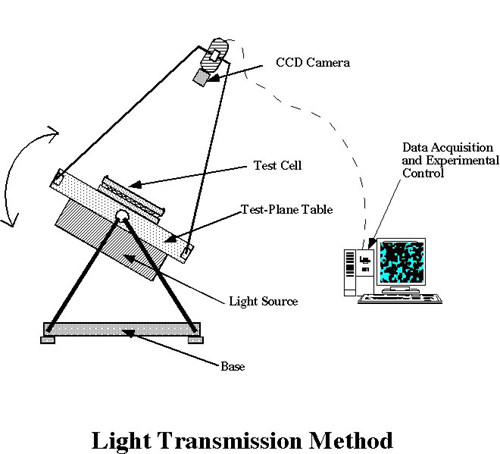Fundamental study of multiphase flow and transport processes within heterogeneous fractured media requires experimental techniques to measure state-variable and property data a high spatial and temporal resolutions.
We developed unique, high-resolution, 2-D field Transmitted Light Imaging Systems for use in thin (0.01 to 25mm thick) but extensive, translucent and transparent experimental systems. With our imaging system, the local thickness averaged liquid/gas saturation, solute concentration, fracture gap (aperture), and/or porous media porosity are measured as varitions in transmitted light intensity at millions of points across the 2-D field through the use of high resolution, low noise digital cameras. Gas/liquid saturation causes intensity variation by a closer matching of the index of refraction of the matrix and liquid relative to the matrix and gas. In test cases where the system was liquid saturated or the gas-liquid saturation field was steady, conservative dyes were used allowing simple light absorption to govern variations in the transmitted light intensity. A combination of theory and calibration is used to map intensity fields into quantitative fields of interest.
The light source used in our systems was a bank of high-frequency (60 MHz), high-output fluorescent lights. Light output from the fluorescent light bank was controlled in time and space through feedback circuitry. The transmitted light intensity field was recorded by means of a CCD (charge coupled device) camera focused on the front of the experimental cell. Depending on the camera used, output was digitized into an array of 512×512 (low-resolution) to 2048×2048 points with gray level ranges from 256 (8-bit) up to 16384 (14-bit) according to the transmitted light intensity. Transmitted light images were collected at rates from several times a minute at full spatial and gray scale resolution up to 30 images per second at lower (512×512) resolution. Fluorescent light bulbs, filters at the light source and at the camera were used to optimize camera dynamic range with respect to the measurement of interest. This technique required that the imaged system be transparent or translucent. Textured glass was used to create controlled fracture systems and glass or epoxy casts were used to fabricate transparent fractures from actual rock fractures collected in nature.
